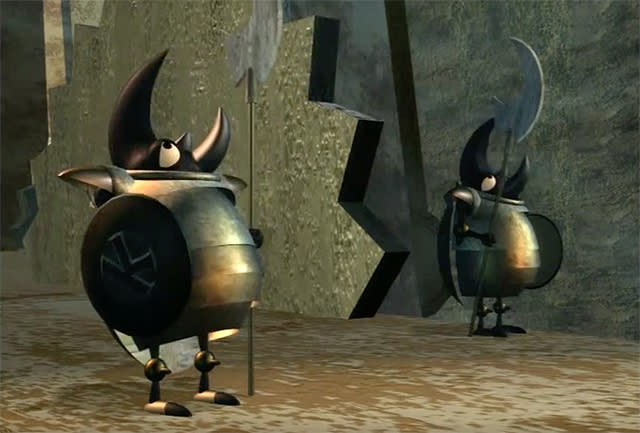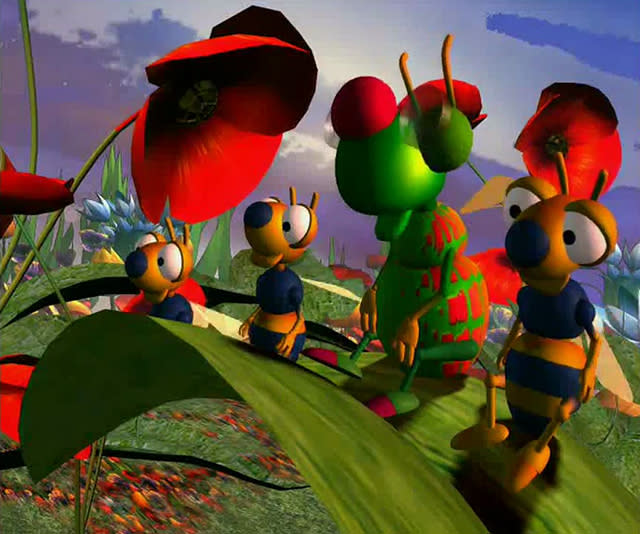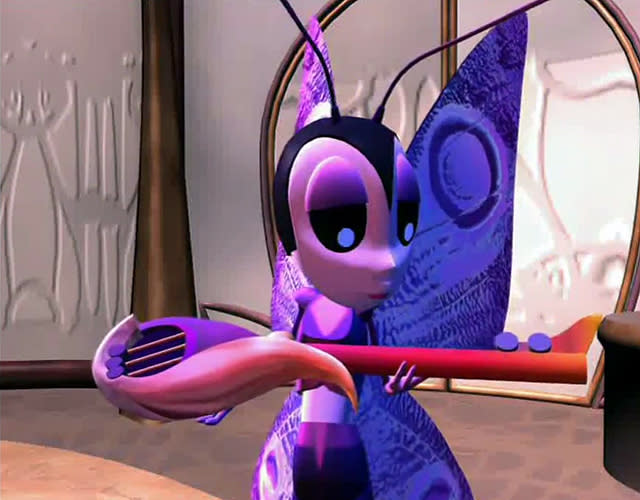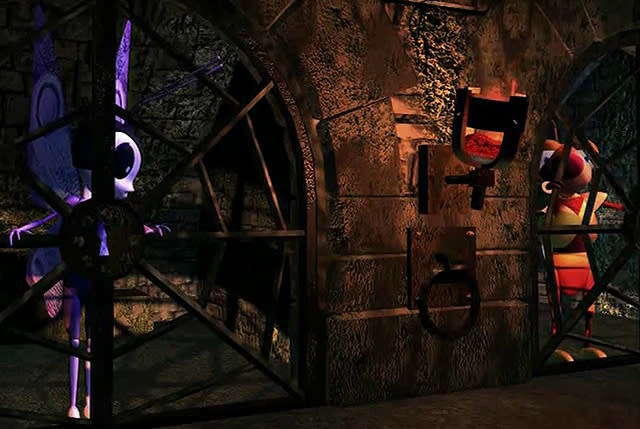The forgotten pioneers of computer animation
How a small French studio made ‘Insektors’.
Everyone remembers ReBoot. It's hard to forget the show's lead character -- a bright blue 'guardian' named Bob -- and his fight to protect a city inside a computer. The computer-animated series premiered in September 1994, months before Pixar stunned theatergoers with Toy Story. It was a groundbreaking show that allowed its creator, Mainframe Entertainment, to pursue similar projects like Shadow Raiders and Transformers spin-off Beast Wars.
Today, many believe that Mainframe was the only company to debut a computer-animated TV show in 1994. But that's incorrect. The Canadian studio had a European peer called Fantôme ("ghost" in French), which developed an equally important and pioneering series called Insektors.
The short-lived show followed a fictional war between two insect races: the heroic and brightly colored Joyces, and the evil and monochromatic Beurks. You could appreciate most episodes on their own, but some had small story and character developments that carried over into subsequent episodes. In episode one, for instance, the heroic Fulgor receives a pollen-shooting guitar-gun that becomes his primary weapon for the rest of the show. Insektors was also a comedy that used a mix of gags to poke fun at the Beurks and their usually dim-witted foot soldiers.
Fantôme's show had a pilot, two 13-episode seasons and a couple of special episodes. It premiered in 1994, the same year as ReBoot, and was effectively cancelled two years later. It's unclear which came first -- some believe Insektors began in April, a few months before ReBoot, while others think it debuted in December.
Regardless, Fantôme has another claim to the coveted title of 'first computer-animated television show.' Before Insektors, the company made Les Fables Géométriques ("Geometric Fables"), a collection of 50-or-so shorts first broadcast in 1990. Most episodes were based on fables written by the French writer Jean de La Fontaine or Greek storyteller Aesop. The characters were humorously recast, though, as geometric shapes. In 'Le Corbeau et le Renard' ("The Fox and the Crow"), for instance, the crow is a black box with a shallow yellow disc for a beak. The crafty fox, meanwhile, is an orange cone with a brown, spherical nose.
"We consider that we made the first CG [animated] TV series," Gilbert Louet, one of the show's animators and, later, the animator director for Insektors said. "It was not Insektors, but it was Les Fables Géométriques."

Fantôme was created in 1985 by Renato, Georges Lacroix and Jean-Yves Grall. The team always wanted to specialize in 3D animation and dreamed of "eventually making a full-length animated feature film, just like Toy Story," Lacroix told Animation World Network (AWN). The company was actually split into two parts: Fantôme Animation, which developed its cutting-edge TV shows, and a broader division that worked on TV commercials for outside clients.
According to AWN, Fantôme started thinking about Insektors in 1991. Les Fables Géométriques was nearly complete, and the team was keen "to make something higher," according to Louet, with an epic story and characters that demanded more than a five-minute runtime. "Something much more important and serious," he recalled. Les Fables Géométriques had run on Canal+, a premium TV channel, and France 3, one of the largest public TV stations in the country. Management at Canal+ liked Fantôme's work and was interested in broadcasting shows that utilized new technology and effects.
The credits that scroll at the end of every episode reveal that Renato came up with the original idea for Insektors. He's also listed as one of the show's creators alongside Lacroix. In 1992, the team created a video that served as both a pilot and 'making of' documentary. The dual format was likely meant to impress broadcasters but also explains some of the unique technical challenges they would be facing. At the time, computer animation required expensive hardware and software licenses. Securing the necessary budget was, therefore, no simple task in France.
With the show approved, Fantôme looked for a scriptwriter that could develop its ideas into a structured season. The company asked animation studio Ellipse Programme, one of the project's co-producers, for help and gained an introduction to Eric Rondeaux. The writer had worked with Ellipse on The Adventures of Tintin (1991), a well-regarded adaptation of Hergé's iconic comic books. "I was a huge fan of Hergé," Rondeaux told Engadget. "I think he's kind of a genius." The show's quality can be attributed, in part, to Rondeaux's unwavering commitment to the source material. "Sometimes I had to fight against the production company to get closer to the books," he said.
"[It] wasn't very sophisticated in its universe and characters, but it was lots of fun."
The writer liked technology and was aware of how CGI was developing in both the film and TV industries. But he had no experience with computer-driven animation. "I knew what it was," he explained frankly. "The idea, and intellectually. But I had no experience. Nobody [at Fantôme] had any experience! Well, almost."
Rondeaux agreed to meet with Fantôme and thought the concept for Insektors sounded "very cool" and exciting. The insect war was a simple idea -- a classic tale of good versus evil -- but flexible and intriguing. "It had to be [simple]," Rondeaux explained, "because we couldn't afford to be too sophisticated. So [the show] wasn't very sophisticated in its universe and characters, but it was lots of fun. Because we knew we had these technical limitations."
Fantôme held weekly writing workshops to develop the stories and eventual scripts for each episode. The group included Rondeaux, Renato and, later, two additional screenwriters, Marc Perrier and Veronique Herbaut. "Obviously, I couldn't write all of the series," Rondeaux said. The writing team would spend the day conceiving and discussing ideas. Each member would then split up and work in isolation before reconvening the following week. This writing setup is common in the movie and TV industry, but Fantôme didn't know that.
"We had no idea about workshops or things like that," Rondeaux admitted. "We did all of that by instinct. It was natural, in a way, to work that way. And now it's all about that in France: 'We should work in workshops, we should do as [the] Americans [do].'"

The company then had to bring its ideas to life. Ferdinand Boutard, a former animator at Fantôme, said the director(s) -- typically Renato and Lacroix -- and Louet would assign everyone shots to animate. Management would then review those shots, give time for adjustments and review them again. If an animator did good work, they would be given more difficult and creatively stimulating shots next time. Conversely, animators who struggled were given simpler and likely more boring shots.
"[Louet] always tried to give you a shot that matched your skills," Boutard said.
Fantôme used hardware built by Silicon Graphics, a California-based company that initially specialized in 3D graphics computer workstations. According to the Fantôme website, these included the low-end, electric-blue Indy workstation; the larger and more capable Indigo, along with its eventual successor, the Indigo2, and the Challenge L and XL multiprocessor server computers.
Boutard said they were "slow" but "ordinary" machines for the time. "Not the best ones," he told Engadget. "[But] not the worst."
The company had used a piece of software called Explore, developed by Thomson Digital Image (TMI), to create Les Fables Géométriques. According to Louet, the software was great for modeling, texturing, lighting and rendering. "But not for animation," he explained. "[For that] it wasn't so sophisticated. We wanted to make complex animation and Explore wasn't easy for doing that." To solve this problem, the team exported its models into a second piece of software called Softimage 3D, which was better for animation. The program was commonplace in the industry and had been used for digital effects in Hollywood movies such as Alien 3 and Jurassic Park.
Once Fantôme had completed the animation, the data was imported back into Explore. "It was a strange pipeline, but it worked," Louet said.
Fantôme targeted two to five seconds of animation per person per day, according to Louet. That meant working some long and gruelling hours. Boutard joked that animators "were just like mercenaries." They would eat together and take turns to cook for one another. Staff would also work through the night to hit deadlines and deliver the show on time. It was a hard but necessary routine to realize the company's dream. "This is the right way to do things," Boutard said. "[Pushing] forward! But doing one [thing] after another. In the right order."

Insektors is unique in having two wildly different English dubs. The first, designed for North America, made a few minor changes -- the Beurks are called Yuks, for instance -- but mostly stuck to the original French scripts. The other dub, meant for the UK, altered reams of dialog and switched up almost every name and fictional term in the show. "It wasn't the same dialogue, but it was funny too," Louet said. The Joyces became the Verigreens, for instance, while the Beurks/Yuks -- now known as Kruds -- have names like Lord Draffsack, General Wasabi and The Methane Brothers, or Miff and Eric.
The biggest difference between the two English dubs, though, is the voice actors' deliveries. In the UK version, almost every character has a heavily regionalized accent. Some mimic Welsh and Yorkshire citizens, while others imitate the Queen-like pronunciation of southern England. These choices compliment the dialogue changes. In the opening episode, for instance, a grumbling bug says with a Lancashire twang: "Call this a concert? I've had more fun at Wigan Job Centre." Later in the season, Godfrey, the wise but eccentric Verigreen leader, shows Flynn a seed that can instantly spawn beautiful flowers: "I'm thinking of entering it into the Chelsea Flower Show," he says with perfect received pronunciation.
There's no definitive version of Insektors. Many of Fantôme's former employees are fond of the UK dub and its regionalized accents, though. "That was a very good idea that we didn't have in France," Rondeaux said. "I regret that we couldn't do that kind of thing [over here]. Because we don't use regionalized accents in France. But I think that's a mistake."
The Musical Color Gun Season 1, Episode 1

Summary
The camera flies over the Verigreen territory and into a tower where some bees are depositing colorful pollen. On a lower floor, Godfrey reveals his latest invention, a pollen-shooting guitar, to Alex. "Hit a Krud with that and they'll find themselves well on the way to becoming a Verigreen," Godfrey explained. "Ingenious, isn't it?" Alex takes the instrument to Flynn, who plays a few chords and accidentally infects a couple of nearby Kruds. The evil minions then fall back and report the invention to Lord Draffsack, a grouchy and egotistical cockroach. Sensing danger, he orders Wasabi, the Krud commander in chief, to quietly steal it from the Verigreens.
Wasabi takes Corporal Fugg, a dimwitted weevil, into the woods where Flynn and his best friends, Elmo and Peg, are sleeping. Fugg steals the instrument but accidentally trips and plays the instrument, which wakes the Verigreen trio. They give chase but are quickly knocked into a puddle by Wasabi. Flynn is dazed but realizes that the dirty water has tainted his usually colorful limbs. "I've just had a brilliant idea," he exclaims. Flynn and Elmo pretend to be Kruds and successfully sneak into the enemy base. They retrieve the guitar from Draffsack and Lord Synapse, the Krud's chief engineer, and board the Insektors equivalent of a hoverbike.
Three Kruds, including Wasabi, give chase on a hoverbike of their own. Godfrey and Alex, meanwhile, are waiting for Flynn to open a concert back in the Verigreen kingdom. "He's probably still in bed," Alex replies with a sigh. Back at the Krud base, Flynn and his friends realize that the hoverbikes have limited fuel. They fly up toward the sky, ditch the vehicle and use their insect wings to escape. Wasabi and the beetle-inspired guards, meanwhile, plummet into the ocean. Somehow, Flynn makes the start of the concert and plays a rock-and-roll riff which, because of Godfrey's modifications, also triggers a colorful firework show.
Memorable quote
"Is that better, Peg? Massage, bit of accupressure. Can't have you tense before the concert."
US dub
UK dub
Fantôme was aware of ReBoot, but it's not clear if the company had any relationship or direct correspondence with Mainframe. "After work we watched some [animated] features and other things," Louet recalled. "About ReBoot, we think it was not so... so beautiful."
"About 'ReBoot', we think it was not so... so beautiful."
According to the animation director, Insektors was broadcast first on Canal+ in France. The channel requires a subscription, which meant the episodes, despite being shown in a primetime evening slot, had a limited audience. After six months, the show aired on France 3, a mainstream entertainment channel that's free to watch. That should have been Fantôme's big moment, at least domestically, but Insektors failed to break out and become a massive hit.
Rondeaux believes that France 3 was partly to blame. Early in the show's production, he attended a meeting with the channel's head of youth programming and tried to explain the concept both narratively and technically. "She told us something like, 'You know guys, I don't understand anything. I don't get anything that you're talking about. I just trust you, do whatever you think is good. But I don't get it,'" Rondeaux recalled. The broadcasters were supportive and thrilled by the idea of making the first computer-animated show. "But they didn't know what to do once they had it," he said.
According to Rondeaux, the executives didn't realize or believe that adults would appreciate the show's humor. That created some confusion about when to air the show on France 3. "If you broadcast it at 8 o'clock in the morning, just before the kids go to school, you've missed the point," Rondeaux said. "You've missed your target. I think that's what they did. I think that's why the series didn't go [down] so well in France."
The show was a critical success, though. Throughout its two-season run, Insektors picked up more than 30 awards, including an International Emmy Award in the Children and Young People category in 1994.

The reaction was large enough to secure a second season. Like the first, it had 13 episodes that ran for 12 minutes each. (ReBoot episodes, for comparison, were 23 minutes long.)
The production had one major difference though: motion capture. In the early 1990s, Canal+ bought a production company called MediaLab, which specialized in the technique. According to Louet, Canal+ effectively mandated that Fantôme utilize its newly acquired asset to make Insektors season two. "They paid [us partly] with services," he explained. "With this company."
Fantôme had already bought a motion-capture system by Polhemus and done some exploratory tests. "I remember that I was not convinced of this technique," Louet said. "I always preferred keyframe animation." Still, the team went along with Canal+'s demands. Louet became a supervisor for the motion-capture work and spent roughly half his time at the MediaLab office in Paris. Like Fantôme, the company used an electromagnetic Polhemus system to track objects in three-dimensional space. According to Louet, two people were required to capture a single Insektors character. One person acted as puppeteer, moving the head and associated features, such as the eyelids, mouth and, depending on the insect, antenna. An actor, meanwhile, became the body.
It wasn't perfect, but the two companies were able to produce enough motion-capture data for roughly one episode each week.

Back at Fantôme, Renato and Lacroix continued to push the team and slowly assemble the show. Magali Rigaudias, one of the company's animators, remembers Lacroix as a "pioneer" and driving force behind the company and its technological capabilities. "He was extremely passionate about 3D and the work that his company was producing," Rigaudias said. Renato, meanwhile, took on a broader creative role. Boutard said he was "a really nice guy" but also comprehensive and clear in his vision for each scene.
Together, they made a great team. Behind the scenes, though, the pair were fighting to keep the show and their company alive. Louet remembers how difficult it was for Lacroix to talk about the show's budget with broadcast executives. "Because each time we came back to see Canal+, they [would] say 'Okay but now it's too expensive, so you have to do it cheaper,'" Louet explained. Fantôme had already agreed to motion capture as a way to cut costs. The team's hardware and software preferences, however, meant the show was more expensive than a traditional 2D-animated series.
As the team worked on season two, it soon became clear that the broadcasters wouldn't be approving a third. "We were all hoping for a third season, or maybe a feature film, but unfortunately it didn't happen," Rondeaux said. "For a lot of reasons, very complex reasons that I can't really explain." The team was able to make a Christmas special, though, which was released in 1996. It also secured another project, Tous Sur Orbite (All On Orbit), which taught children about the solar system. Like Les Fables Géométriques, these were short episodes that didn't stretch the company's storytelling abilities.
The Prince of Rock Season 1, Episode 9

Summary
General Wasabi and Corporal Fugg investigate some strange sounds by boat. They soon find a pack of Verigreens, including Godfrey, hitting instruments and nearby flowers to create music. "Pull over to the bank immediately," Wasabi yells at Fugg. "[I] must stick weeds in [my] ears!" Enraged, the pair retreat and ask Lord Draffsack for help. The grouchy cockroach sends out a group of Kruds with earplugs, who are impervious to the Verigreen's jubilant music. They swiftly capture the show's colorful heroes, including the guitar-playing Flynn, and drag them back to their dreary tower.
Flynn's best friends, Peg and Elmo, search for their friends in the forest. They're soon ensnared by a booby trap devised by Wasabi and Fugg, though. Back in the Krud dungeon, Flynn manipulates some dripping water to create a xylophone-like tune. His efforts encourage the other Verigreens to perform in their prison cells. A portly guard then shouts: "I've warned you Veries before, no jamming!" Elmo and Peg are later brought into the dungeon with, unbeknown to Wasabi and the other guards, Flynn's color guitar gun.
Elmo is too weak to carry the weapon to Flynn's cell, though. Prince Maximillian, a rebellious Krud who loves nature and music, then burrows his way up into Elmo's cell. He agrees to help the Verigreens and plays an impressive guitar solo that knocks out one of the guards. Flynn quickly steals the cell keys and frees everyone. With Maximillian's deadly tunes, the group is able to beat the Kruds and steal a boat at the bottom of the tower. "Come with us Max," the Verigreen butterfly Alex pleads. The Krud prince is grabbed by Draffsack, though, before he can make a decision. The episode fades to black as the Verigreens sail away.
Memorable quote
"Here, Max, you've played before then, haven't you? Right then, you know that great guitar riff on side two of 'Thick as a Plank' by the Wood Weevils..."
US dub
UK dub
After that, the company seemed to crumble. Lacroix, Louet and other Fantôme members experimented with a series called Les Girafes de Mordillo (The Giraffes of Mordillo), which was based on the work of Argentinian cartoonist Guillermo Mordillo. Only two episodes were ever made.
By 1998, the studio was desperate. Lacroix asked for help at a press conference held at the IMAGINA computer graphics festival in Monte-Carlo, Monaco. As AWN magazine reports, the company had been unable to secure the necessary funding for Les Girafes de Mordillo and was now facing closure. Fantôme had struggled, according to an article by Stephane Singier, because there weren't enough clients beyond Canal+ prepared to take the financial risk. "No European bank wanted to invest in the 3D sector, which is looked upon like a circus act," she wrote in AWN's March issue.
"No European bank wanted to invest in the 3D sector, which [was] looked upon like a circus act."
The following month, Lacroix published an open letter asking two French ministers to save the country's 3D-animation industry. He said that the government's "lack of awareness" had caused "several firms to close" and allowed promising software to be sold to American and Canadian companies. "Numerous films using these new technologies have had difficulties finding financing and some have had to be abandoned," Lacroix wrote. The Fantôme founder then recapped his company's shows, including the awards and revenue they had earned. "In spite of these creative and productive capabilities, in spite of its project slate, its international reputation, prestige and enormous potential, Fantôme could disappear, along with other firms who can't find the necessary ingredients for growth in France," he wrote.
The letter didn't seem to make a difference. Fantôme was sold to a Belgian producer and distributor called Neurones in 1999. According to Playback magazine, the studio's new owner wanted Fantôme to pursue its dream projects including an Insektors feature film and a complete series of Les Girafes de Mordillo, consisting of 50 roughly one-minute episodes. Neurones kept six Fantôme employees and asked Lacroix to stay on as the studio's artistic director. Neither project came to fruition, though, and the Fantôme name quickly faded into obscurity.
"Fantôme was dismantled," Rondeaux said. "It disappeared."
Insektors The Game Special

Insektors never had an official video game. Fantôme made a roughly five-minute short, though, about a young boy who plays an interactive version of the show. It's set in 2001 and starts with the main character, Jeremy, controlling his computer with a pointer and VR glasses. The rebellious youth watches a video message from his mother that prompts him to complete some homework. He disobeys her order, though, and plays a portion of an Insektors game using a long, baton-style controller instead. At the end of the short, Jeremy's mother pops up inside the game and scolds him for deliberately procrastinating.
French only
Insektors only ran for two seasons. ReBoot, by comparison, had four during its original run and was revived last year as a live-action and computer-animated hybrid for Netflix. Unlike Fantôme, Mainframe still exists and, with its sister company Rainmaker, continues to produce a mix of TV shows and movies, including Spider-Man: The New Animated Series in 2003 and the Ratchet and Clank film from 2016.
Fantôme never made a full-length feature film. Some of the company's employees, though, have pushed on and realized that dream in subsequent roles. Eric Guillon, for instance, has spent the last decade as a character designer for countless Illumination Entertainment movies including Despicable Me (yes, he invented the Minions), The Lorax, The Grinch and The Secret Life of Pets 2. Insektors, then, still has an influence to this day. And those who worked at Fantôme will always remember with fondness their time at the company.
"The team culture was fantastic," Rigaudias said. "In fact, I'm still friends with most of the people I worked with back then." Rondeaux added: "Sometimes when you look back, everything [seems] very nice, and you forget all the bad things. But honestly, [Fantôme] was really nice."

